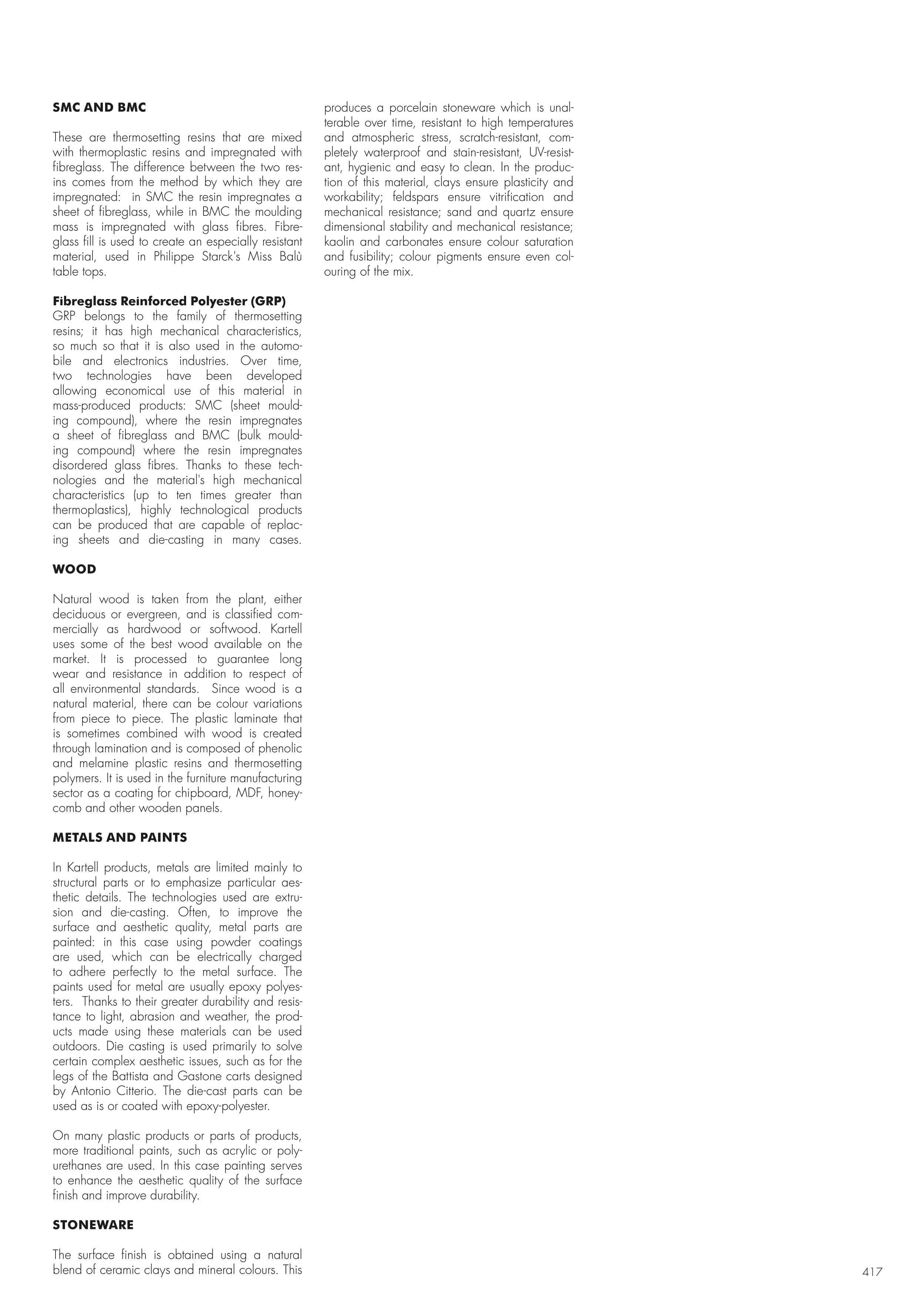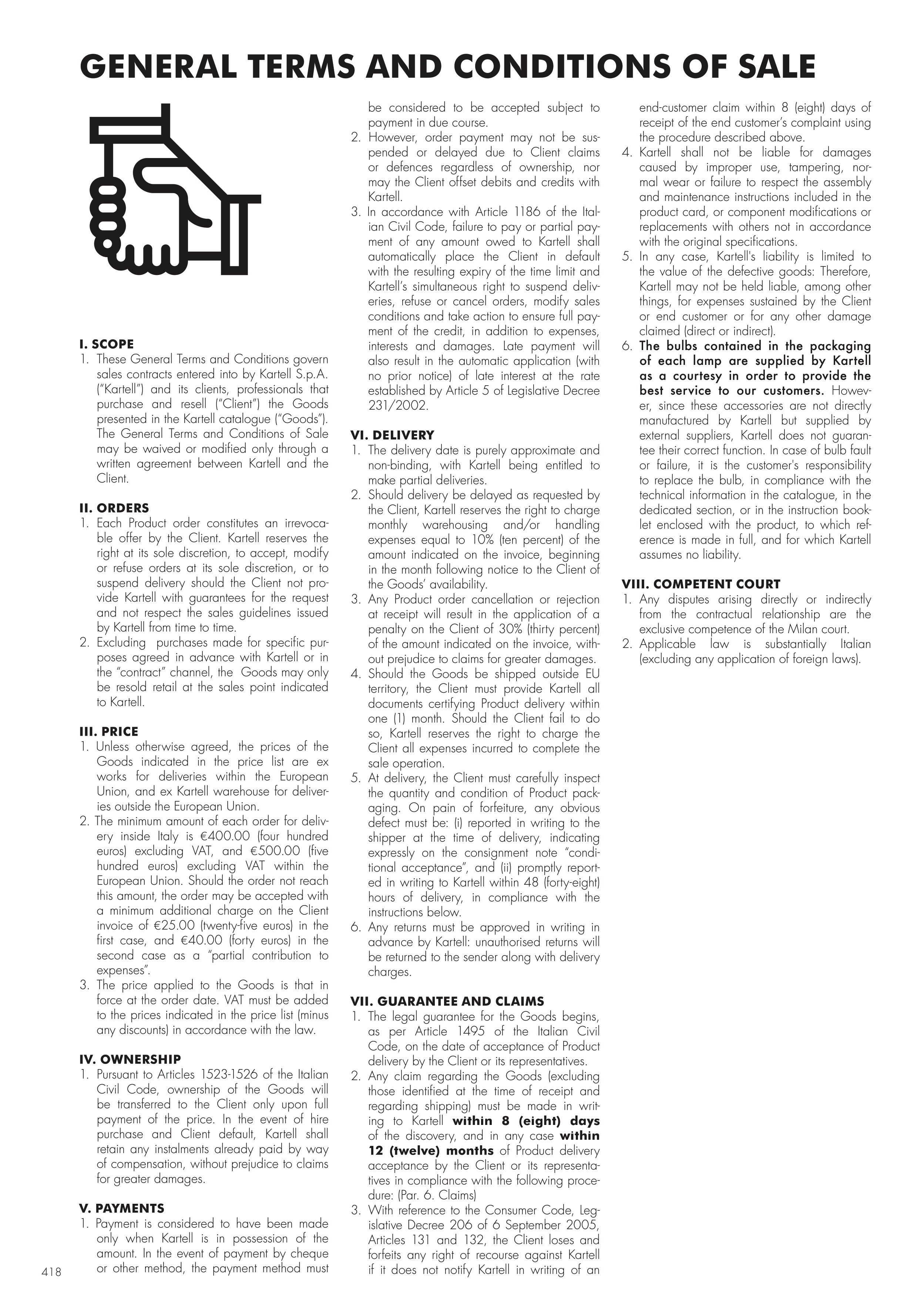417
SMC AND BMC
These are thermosetting resins that are mixed
with thermoplastic resins and impregnated with
fibreglass. The difference between the two res-
ins comes from the method by which they are
impregnated: in SMC the resin impregnates a
sheet of fibreglass, while in BMC the moulding
mass is impregnated with glass fibres. Fibre-
glass fill is used to create an especially resistant
material, used in Philippe Starck's Miss Balù
table tops.
Fibreglass Reinforced Polyester (GRP)
GRP belongs to the family of thermosetting
resins; it has high mechanical characteristics,
so much so that it is also used in the automo-
bile and electronics industries. Over time,
two
technologies
have
been
developed
allowing economical use of this material in
mass-produced products: SMC (sheet mould-
ing compound), where the resin impregnates
a sheet of fibreglass and BMC (bulk mould-
ing compound) where the resin impregnates
disordered glass fibres. Thanks to these tech-
nologies and the material's high mechanical
characteristics (up to ten times greater than
thermoplastics), highly technological products
can be produced that are capable of replac-
ing sheets and die-casting in many cases.
WOOD
Natural wood is taken from the plant, either
deciduous or evergreen, and is classified com-
mercially as hardwood or softwood. Kartell
uses some of the best wood available on the
market. It is processed to guarantee long
wear and resistance in addition to respect of
all environmental standards. Since wood is a
natural material, there can be colour variations
from piece to piece. The plastic laminate that
is sometimes combined with wood is created
through lamination and is composed of phenolic
and melamine plastic resins and thermosetting
polymers. It is used in the furniture manufacturing
sector as a coating for chipboard, MDF, honey-
comb and other wooden panels.
METALS AND PAINTS
In Kartell products, metals are limited mainly to
structural parts or to emphasize particular aes-
thetic details. The technologies used are extru-
sion and die-casting. Often, to improve the
surface and aesthetic quality, metal parts are
painted: in this case using powder coatings
are used, which can be electrically charged
to adhere perfectly to the metal surface. The
paints used for metal are usually epoxy polyes-
ters. Thanks to their greater durability and resis-
tance to light, abrasion and weather, the prod-
ucts made using these materials can be used
outdoors. Die casting is used primarily to solve
certain complex aesthetic issues, such as for the
legs of the Battista and Gastone carts designed
by Antonio Citterio. The die-cast parts can be
used as is or coated with epoxy-polyester.
On many plastic products or parts of products,
more traditional paints, such as acrylic or poly-
urethanes are used. In this case painting serves
to enhance the aesthetic quality of the surface
finish and improve durability.
STONEWARE
The surface finish is obtained using a natural
blend of ceramic clays and mineral colours. This
produces a porcelain stoneware which is unal-
terable over time, resistant to high temperatures
and atmospheric stress, scratch-resistant, com-
pletely waterproof and stain-resistant, UV-resist-
ant, hygienic and easy to clean. In the produc-
tion of this material, clays ensure plasticity and
workability; feldspars ensure vitrification and
mechanical resistance; sand and quartz ensure
dimensional stability and mechanical resistance;
kaolin and carbonates ensure colour saturation
and fusibility; colour pigments ensure even col-
ouring of the mix.



